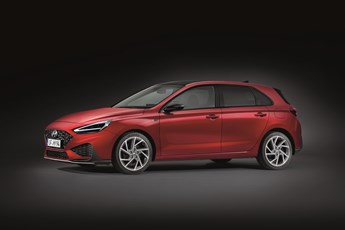We use cookies to ensure that we give you the best experience on our website. If you continue without changing your settings, we will assume that you are happy to receive all cookies on the Business Car website. However, if you would like to, you can change your cookies at any time

The start point for the best source of fleet information |
First drive: Hyundai i30
Date: 07 October 2020 | Author: Simon Harris

|
|
||||||||||||||||||
Mild-hybrid technology is becoming so common these days it's arguable whether we should distinguish such vehicles as hybrids at all.
Often a 48V system, but sometimes merely 12V, the electronics assist the engine during acceleration and can reduce fuel consumption and CO2 emissions.
So, despite our scepticism over the terminology, they are still a positive development, especially as they are becoming more widespread, with the potential to help new cars reduce the level of pollutants in exhaust gases, even if it's by a small margin.
Hyundai has been gradually rolling out the technology in its range, beginning with the Tucson last year, and the i30 is the next recipient among the current line-up.
Hyundai has also taken the opportunity to give the i30 a minor revamp after a few years on sale, with a refreshed appearance and new technology.
The updated model has a wider grille, giving it greater presence on the road, and new, slimmer headlamps come with an arrow-shaped LED signature (as well as the option of LED headlight technology too).
A revised rear bumper on the five-door hatchback is said to improve aerodynamic performance, and a new LED signature design in the rear lights echo the front end. There are also new alloy wheel designs available.
Perhaps of greater interest to company car drivers, who appear keen on the sportier-looking grades, the N Line variants have undergone a more comprehensive design update, with a restyled lower bumper section and new rear bumper that includes a wide diffuser and repositioned fog lamps.
The N Line hatchback and Fastback variants have also undergone tuning changes for the suspension and steering for a more engaging ride. A new 160hp turbocharged 1.5-litre petrol engine with the 48V mild-hybrid system will only be available in the N Line grade in the UK, although other engine variants will also be offered as N Line models.
The entry point to the range will be a 1.0-litre three-cylinder turbocharged engine developing 120hp, and will be offered with a six-speed manual as standard or seven-speed dual-clutch auto as an option.
It will also be possible to specify that engine with the 48V mild-hybrid technology, and a new 'intelligent manual transmission', which Hyundai says decouples the engine from the gearbox when the driver lifts off the accelerator, with revs falling to idle levels and reducing fuel consumption. The 48V hybrid version can also be chosen with an optional seven-speed dual-clutch auto.
And the 136hp 1.6-litre diesel engine also gets the mild-hybrid treatment in the updated i30, with the same, clever manual transmission as standard, or the seven-speed DCT as an option.
Among the i30's other updates are redesigned interior air vents and a new pewter-grey trip option.
Unlike the new i20, which is available with a digital instrument display, the i30 is merely updated, so retains its analogue instruments, although it has a new 7in 'digital cluster' within the instrument binnacle with various information about the car's systems accessible.
It is offered with a new 10.25in central dashboard touchscreen, and Apple Carplay and Android Auto functions are available through wireless phone mirroring - there will be no need to connect a USB cable. Wireless phone charging will also be available on the i30.
The car also comes with the option of Hyundai's latest connectivity, called Bluelink, as well as Hyundai Live Services, incorporating real-time traffic information powered by TomTom, and information on nearby filling stations, parking spaces, speed cameras and the weather.
The Bluelink smartphone app includes a 'find my car' function, remote locking, sending addresses to the car's navigation, alarm notification, and maintenance issues such as tyre pressure.
The safety systems available are enhanced with an automatic braking function if the driver doesn't respond to a rear collision warning when reversing out of a parking space, as well as an alert if the vehicle in front has moved on when sitting in traffic.
These are in addition to lane departure warning and lane-keeping assistance, and automatic dipping high-beam, plus others that were previously offered on the i30.
Our drive was in a pre-production version of the new 1.5-litre N Line grade, so it wasn't quite in the form signed off for production, but the indications were promising.
In our relatively short drive on mainly country roads the car always felt keen and responsive while keeping movement under control.
The N Line suspension is firm, but clearly there is a trend here with rival products also going down the same route. And, like the best of its rivals, the i30 seems to respond intuitively to steering inputs.
We know Hyundai has been working hard in recent years to develop entertaining and rewarding chassis for driving enthusiasts, and while there might not be many among those currently in a Hyundai i30 company car, the N Line demonstrates this particular aspect of the driving experience is being taken very seriously by the company.
We look forward to trying a production version in due course, and hopefully the message is getting across to fleet customers that the Hyundai range has some gems that are deserving of better visibility.
Verdict |
8/10 |
|||
 |
|
 |
|
|











